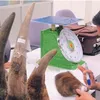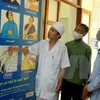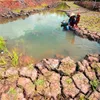Việt Nam raises warning level for Zika virus
A report from the World Health Organisation also confirmed the virus was rapidly spreading across the world. The ministry’s emergency operation centre (EOC) held a meeting yesterday and said health authorities at all levels should intensify urgent measures against the spread of the virus in the country.
Deputy Minister of Health Nguyễn Thanh Long, who chaired the meeting, said Việt Nam needed to raise the warning level in the whole healthcare system and take all urgent preventive measures to actively prevent an epidemic from breaking out.
The deputy minister asked all healthcare units to complete all preparations for the fight against the spread of the virus. The MoH’s Việt Nam General Department of Preventive Medicine said it had received a report on March 22 that an Australian visitor had tested positive for Zika on his return from Việt Nam.
The visitor had stayed in Việt Nam from February 26 to March 6, during which he travelled to HCM City, Lâm Đồng, Khánh Hòa and Bình Thuận provinces.
Following the report, the EOC said there was a very significant risk of Zika’s spread across Việt Nam.
The MoH yesterday asked the Central Highlands province of Lâm Đồng to raise the warning level for the Zika virus.
Lâm Đồng is at high risk of a Zika outbreak, as its resort city of Đà Lạt receives several foreign visitors.
Therefore, the provincial health department has intensified epidemic supervision at residential areas and tourism sites, especially those that attract foreigners.
Lâm Đồng’s General Hospital No 1 and No 2 yesterday started collecting samples of blood and body fluids from people who have had symptoms similar to Zika, such as fever, rashes, muscle pain and joint pain, as well as headache and conjunctivitis.
The health department also intensified communication programmes about the disease and its symptoms, while organising training courses to improve its staff’s abilities.
Zika, first detected in Uganda’s Zika Forest in 1947, is transmitted to humans by the Aedes mosquito, which is also the main carrier of dengue fever. Besides leading to symptoms such as mild fever, rashes, muscle pain and joint pain, as well as headache, pain behind the eyes and conjunctivitis, the virus has been linked to microcephaly, a condition that causes babies to be born with unusually small heads and, in the vast majority of cases, brain damage. There is currently no cure for the Zika virus and no vaccine.
According to the World Health Organisation, 59 countries and territories have recorded cases of Zika so far. Some foreigners have also tested positive for Zika after departing from Southeast Asian countries such as Thailand, the Philippines, Indonesia and Malaysia.





